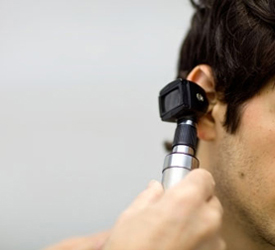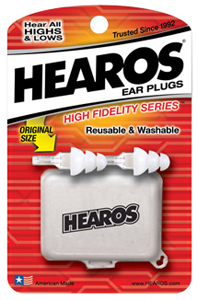The Uninsured Musician's Guide to Not Going Deaf
I had a disconcerting moment earlier this week. While out for a mid-afternoon stroll, I rounded a corner and suddenly felt an unusual pressure in my right ear. In just a few footsteps, my hearing grew dull and I experienced the strange and unwelcome sensation that someone or something had plugged my ear canal full of miniature marshmallows.
Suddenly going deaf in one of your ears is enough to send any musician or engineer into a brief existential crisis. You can console yourself for a moment, remembering that hey, this kind of thing didn’t stop Brian Wilson or Beethoven. That is, until the far more realistic thought sets in: You’re not Beethoven.
The Leading Cause of Temporary Hearing Loss
Like many musicians, engineers and other freelancers, I’m one of the 60 million Americans who lack access to affordable health insurance. This means that when I’m stricken with some kind of unknown ailment, I tend to run to Google instead of my doctor, since I do not have a doctor.
While I’ve been able to heal myself of two slipped spinal discs and an abdominal hernia using corrective exercises and remedies found online, I still don’t recommend this method to anyone, including you. It’s likely that you’re out of your element when it comes to medicine, just like I am, and trust me, I know firsthand that self-diagnosis is no replacement for a physician’s care.
With that said, we can talk about something that’s arguably even more important than cure: prevention.
Swimmer’s Ear
As I continued my walk, I tugged downwards on my earlobe and was thankful to find that my hearing returned for a moment. As I released my ear, the canal closed up again and the hearing in my right ear was again reduced to a dull, pillowy murmur.
Because I’m a giant idiot, I decided to try something that each one of my sources would eventually confirm as being a very dumb thing to do.
Like so many similarly soft-headed morons around the country, I assumed the obstruction was due “too much wax” and grabbed the first thing I could think of to help me remove it. Even the Q-Tip package could have told me what I was about to do was wrong: “Not for use inside the ears.”
This is because what I experienced, along with more than 2.1 million other Americans each year, was not a foreign obstruction or what’s commonly mistaken for an undue buildup of ear wax. Rather, what took out my right ear for a good 24 hours was a condition that’s among the leading causes for temporary hearing loss in the U.S., especially in the summer months: “Swimmer’s Ear.”
This is a condition that’s so common, but so surprising to many of us, that it accounts for up to 40% of all the emergency room visits in southern states, where it’s most prevalent.
Here in the Northeast, where the condition is less common, Swimmer’s Ear still accounts for nearly 20% of all of our total emergency room visits. This is a staggering figure that is estimated to cost our healthcare system nearly $500 million each year.
Swimmer’s Ear is caused when bacteria or fungi – who think that water is the bees knees, and that your ear is a neat place to live – find their way in there and start getting fruitful and multiplying.
The most common causes of Swimmer’s Ear are freshwater swimming, saltwater swimming, pool swimming and tap water from the bath, in that order. (I got mine while whitewater rafting in the Delaware River.)
What To Do About It
Like so many millions of Americans, when I felt as if something was blocking my ear canal, what I was actually experiencing was internal swelling in response to an infection.
The number one thing NOT to do if you ever feel like there’s an obstruction in your ear is to use any kind of object to clear out the pathway. Counter-intuitively, trying to clear the obstruction or remove wax from your ear with a Q-Tip only makes matters worse.
This strategy actually increases irritation and swelling and tends to lead people into freaking out and driving to the emergency room. (Thankfully, I didn’t get that far.) And, if you are successful in removing a heap of earwax from your ear (rather than just impacting it against your eardrum, which doctors say is far more likely): then congratulations. You’ve just effectively removed your ear’s built-in cleaning fluid, and your body’s one natural defense mechanism against further infection.
However, if you’re lucky enough to catch your case of Swimmer’s Ear while it’s just beginning you may be able to effectively disinfect the area before it’s too late.
Instead of poking around in your ear with a stick like Cleetus the Slack-Jawed Yokel, you can make yourself a solution of 50% rubbing alcohol and 50% white vinegar.
If you’ve never had ear surgery and you’re certain that you don’t have a ruptured ear drum, you should be able to safely drip this solution into your ear using an eye-dropper, an empty contact lens bottle, or a sterile syringe (minus the needle, of course.)
If you’re as lucky as I was, this solution will kill the bacteria and fungus before they get a foothold and allow you to avoid a full-blown case of Swimmer’s Ear.
If you’re unable to catch it in time, a doctor will need to prescribe you up to 2 weeks worth of prescription antibiotic drops to cure your ear. If left untreated, the infection and swelling can reach a point where you wind up with a ruptured eardrum – And hearing that will never be quite the same again.
Prevention
The best way to beat Swimmer’s Ear is by not getting it in the first place.
If you’re prone to these kinds of infections or if you plan to work with sound immediately after swimming, waterproof earplugs or a swimming cap can stop water from getting into your ears.
Some of the same folk remedies that are used to good effect in the early stages of Swimmer’s Ear can also be effective for prevention if your ears become filled with suspect water.
Rubbing alcohol kills germs and helps with the evaporation of trapped water. Both apple cider vinegar and white vinegar have anti-fungal properties that make them popular preventative remedies. And don’t underestimate the power of a good hairdryer in helping to gently dry out your ears before an infection can take hold.
If you’re like me and the countless thousands of Americans who have created an impenetrable wall of impacted earwax by jabbing a Q-Tip in there, please quit while you’re ahead. If you need to get past this obstruction in order to disinfect your ear, you can soften the earwax with Carbamide Peroxide, which is sold over-the-counter as generic “earwax removal aid” or under brand names such as Debrox.
But please, don’t go crazy with it. Remember that wax was put in your ears by nature to clean and protect your hear-holes. If you ever suffer from decreased hearing sensitivity or stuffy ears, the underlying problem is likely to be swelling due to infection or irritation. If you do start to produce more earwax than usual, odds are that it’s there to help fix that problem, and trying too hard to remove it is likely to make matters worse.
The Leading Cause of Permanent Hearing Loss
Although an ear infection can lead to deafness if left untreated, it’s relatively rare for Swimmer’s Ear to cause more than a temporary hearing loss in industrialized nations.
In countries like ours, the number one cause of permanent hearing loss is prolonged exposure to loud sounds – and you might be surprised by just how low our thresholds are.
Both The House Research Institute and The Center for Hearing and Communication estimate that over 37 million Americans, or roughly 12% of the population, suffer from significant hearing loss. Look at adults over age 65 and that percentage skyrockets to near 33%.
Ironically and sadly, that figure is likely even higher among musicians, audio professionals and music fans – Precisely the people who value their hearing the most.
To help us retain our hearing Marilee Potthoff, Director of Outreach and Education at The House Research Institute, says that her organization recommends we significantly limit our exposure to sounds exceeding 85 dB in level.
At 88dB, guidelines from House Research and The Center For Disease Control recommend no more than 4 hours of exposure. At 91dB, they suggest a 2 hour maximum. At volumes approaching 100 dB, they recommend just 25 minutes per day to avoid long-term hearing loss, and at 105 dB, no more than a few minutes is advised. Most troubling of all, at 115 dB – the volume level of a typical rock concert – Potthoff says there is no length of exposure that can be deemed safe.
If you’re one of the 50 million Americans who have experienced Tinnitus, or “ringing in the ears” after a loud concert, this means that you’ve suffered a loss in hearing that will never come back. Hearing loss from high volume music is cumulative, which means that repeat exposure only makes matters worse. But it also means that it’s never too late to stop more damage from occurring in the future.
What To Do About It
Unfortunately, once you’ve suffered long-term hearing damage from loud SPLs, there’s no way to get it back.
Unless you’re a fish, who are among the few creatures that can replenish their hearing capacity (we imagine they’re also immune to Swimmer’s Ear), your ears are not going to fix themselves.
We audio-loving air-breathers have to get smart now, or suffer the consequences long into our ever-expanding working years.
Prevention
Nothing makes teenagers turn a deaf ear like the word “prevention.” No wonder that so many of them are also going deaf in a literal sense. Today, 15% of adolescents between the ages of 6-19 have measurable hearing loss in at least one ear.
Some of this can be blamed on earbuds that are regularly blasted at high volumes. But this isn’t just a matter of kids being irresponsible with their ears. If you ride the subway, chances are that you jack up your listening device loud enough to hear over the oppressive rattle of the train. The sound level of that train may approach 100dB, which is safe for only about 15 minutes a day – So if your iPod is louder than that, you do the math.
This means that one of the best ways to keep your headphones at a reasonable level without compromise is to switch from conventional headphones or earbuds to something that blocks out more exterior noise.
The key here is acoustic isolation, so active headphones that use fancy phase-based noise-canceling technologies are of no help unless they also block out significant amounts of exterior noise through good old-fashioned padding and mass.
The same principle applies for uber-loud full-band tracking sessions. If you have solid headphones that provide ample acoustic isolation, such as the Sennheiser HD-280 or the Direct Sound EX series, your players won’t have to crank them quite so much to hear themselves clearly.
Alternately, you could become an advocate of tracking at reasonable volumes, perhaps even without headphones like on so many of your favorite-sounding classic records – But that’s fodder for a whole other article.
Custom Earplugs
It used to be that the only earplugs you could easily find were the big clumsy foam ones that block out tremendous amounts of sound with little elegance. Although earplugs like these can reduce by as much as 40dB near the center of our hearing range, they do so at the cost of nuance and musical sensitivity.
Thankfully, much better models are available today at a reasonable cost, and today there’s no excuse not to have a few pairs of high-quality reusable earplugs like High-Fidelity Hearos or the E-A-R UltraFits at hand.
For those who want to rock out in style, any good audiologist can fit you for custom-made, reusable, and practically invisible earplugs like those made by Sensaphonics or Etymotic.
Some of the most sensitive and transparent earplugs on the market reduce SPL by as little as 10 – 20 dB. While this is little enough to keep from degrading the sound of the music you hear and perform, it also goes a long way to bringing an ear-splitting 105 – 115 dB concert down to a manageable 85 – 95 dB. And at volumes like that, you can still feel that satisfying thump in your chest without going deaf for it.









Anonymous
July 19, 2012 at 7:54 pm (13 years ago)really great info, didn’t know about swimmer’s ear. I just picked up some Etymotic ER-20’s (which look just like the Hearos), and they’ve been great.
Inputoutputpodcast
July 19, 2012 at 8:59 pm (13 years ago)I is not slack-jawed.
-Cletus
Paul Cox
July 20, 2012 at 10:02 pm (13 years ago)http://www.nytimes.com/2012/07/20/nyregion/in-new-york-city-indoor-noise-goes-unabated.html
TrustMeI'mAScientist
July 21, 2012 at 1:01 pm (13 years ago)Also a good article – and an interesting coincidence. It’s fascinating to see just how often we’re exposed to dangerous levels without being aware or prepared.
Billy
July 23, 2012 at 1:36 pm (13 years ago)any recommendations or good deals on place i could get custom ear molds.
David Weiss
July 24, 2012 at 4:22 am (13 years ago)If you’re in NYC, https://www.sonicscoop.com/2011/05/22/whos-new-musicians-hearing-solutions-opens-to-protect-professional-ears/
Adrian
August 10, 2012 at 12:59 am (13 years ago)I never knew about swimmer’s ear! Thanks for the heads up. As for the permanent hearing loss caused by loud music – I’m sure a lot of it happens in those early years when we all feel invincible and earplugs are for dorks (I still get weird looks from friends sometimes when I pop them in at a ridiculously loud concert). We need some celebrity to make designer earplugs just like they make designer headphones – then they’d be cool!
Andrew
August 22, 2012 at 2:52 am (13 years ago)Good information, should be more of it in our field, especially at the edu level, where I don’t think it is being mentioned beyond “wear ear plugs.” I want to add something because I didn’t know it until I had a scare recently, and all AE’s should know this: If you have a sudden instance of hearing loss (sensorineural hearing loss is the term), and suspect it is not swimmer’s ear, you should seek an appointment with an ENT as soon as possible, like within 32 hours soon. A short burst of corticosteroid can possibly bring damaged hair cells back to life before they crumble! Also, I learned that some audiograms can go to 12k, and ANSI has recommendations for up to 16k audiograms, but that’s exceedingly rare in practice. The standard is 8k. Audiologists, in my experience, are not terribly sensitive to why anyone would care about anything beyond 8k, unfortunately. Audio engineers, demand 12k audiograms!
Roscoe
August 22, 2012 at 6:00 pm (13 years ago)sensaphonics Musicians Ear Plugs cost about $250 including the doctor visit. You really owe it to yourself to get a set. They have many different filter values. I’ve been using -9dB which seems to be a great balance of protection vs excitement. Take care of your hearing. You can’t get it back.
Marcel Williams
September 4, 2012 at 4:35 pm (13 years ago)Great article. It’s so easy to expose your ears to loud noise, even without realising it. As you say, those who listen to music with cheap earbuds in a noisy environment are doing themselves real harm. You need to make sure your headphones have a good noise cancellation feature so you can listen at appropriate volumes.